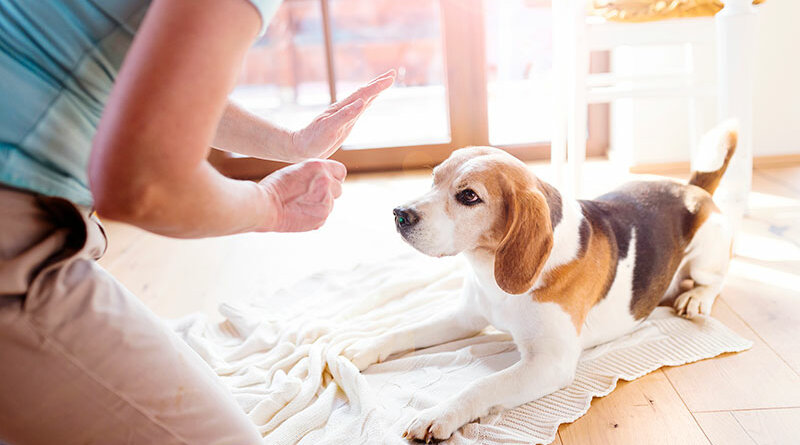6 Reasons to Set Boundaries for Your Dog
Riffs on the Marley & Me story abound for anyone who works with dogs in just about any capacity. People love to share the ways their “little rascal” is so clever and impish—misbehaving in the most lovable and endearing ways. Humblebrags about how someone’s dog is more Marley than Marley himself are common.
Unfortunately, what these tales really do is glorify a dog’s complete lack of boundaries. They also imply that any kind of structure and expectations regarding behavior are impositions on dogs. The subtext is often that dogs are happiest when we don’t guide their actions in any way.
Though the occasional story of a dog running amuck can be entertaining, I reject the idea that this is how dogs should be—wild, free and unencumbered by constraints on their desires and inclinations. In fact, I would argue that by setting boundaries through training, we enhance our dog’s happiness. Trained dogs have better lives precisely because they’re allowed more freedom. In truth, well-trained dogs have many advantages over their Marley-esque counterparts. Following are a few of them:
1. More off-leash opportunities. Off-leash dogs can run full speed, explore, sniff as long as they wish at an interesting spot and make their own choices. Few other activities offer dogs such a quality experience. However, not all dogs can handle being unleashed; some run off, get lost, go into the road or accost others. Dogs who come when called, don’t cross boundaries, and are polite and well-mannered can be safely given the freedom to be off-leash in wide open spaces, such as on hikes or in fields. For dogs without such skills, off-leash opportunities may only be available in their backyard or at the dog park. That means they probably don’t get to be off-leash as often or for as long as well-trained dogs.
GET THE BARK IN YOUR INBOX!
Sign up for our newsletter and stay in the know.
2. Welcome in more public places. A well-behaved dog who knows how to walk nicely on-leash and greet people politely will be welcome at dog-friendly businesses such as coffee shops and retail stores. So, rather than stay at home, your dog can accompany you on errands and outings to such places. Well-mannered dogs have a fuller life with more varied experiences.
3. Welcome to attend social events and co-pilot on trips. A dog with training in basic manners is far more likely to be welcome at social events—from a two-hour book club meeting to a week-long family gathering. “Basic manners” include the capacity to sit, stay, leave it, wait at the door, come, walk nicely on-leash, drop it, greet politely and stop barking on cue. That may seem like a long list, but mastering these behaviors makes dogs so much more pleasant to be around, and that translates to an enjoyable visit for everyone. There’s also a bonus benefit: it’s easier to find someone willing to watch your dog in their home when you need to go out of town without her. While many dogs are perfectly happy in the kennel, a lot aren’t. You’re far more likely to have the option of a friend or neighbor taking in your dog if she’s trained. Here again, rather than being left at home or put in the back room when company comes, dogs with proper boundaries are allowed to socialize and enjoy the festivities.
4. More play dates with other dogs. Dogs with good social skills who don’t leap on people, dig in gardens or run around like unguided missiles are able to have play dates with a variety of dogs. It’s a shame when dogs miss out on the fun because they haven’t had enough training to be able to act appropriately.
5. Better relationships with their human family. The core of our bond with dogs is the development of a strong relationship. Clearly, while it’s possible to be head-over-heels in love with a dog even if she is a “Marley,” such behavior has damaged many a union. It may not ruin the relationship if your dog eats your wedding ring or plants her muddy paws on your new dress, but it doesn’t help it, either. More dogs are surrendered to shelters for behavior issues than for any other reason, and many of those problems can be solved by training the dog to respond to very basic cues. Most people enjoy their dogs more and feel closer to them if their behavior isn’t irritating, dangerous or stressful to the neighbors. I would argue that, as dear as Marley was to his people, there’s nothing more adorable or sweeter than a well-trained, happy, loving dog.
6. More walks. Many dogs are hard to walk because they pull relentlessly, cut in front of people, bark at everything they see, or wrap their leashes around trees and mailboxes as they move chaotically along. Often, this means these dogs aren’t walked as frequently as trained dogs because the behaviors are unpleasant for their people. A shortage of walks may, in turn, make the dog’s behavior worse when she does go out because she’s overexcited and hyperenergetic.
If dogs practice walking and are specifically trained to have nice leash manners, it’s more fun and easier to take them on walks. That means their owners will take them out even if the weather is bad, if they’ve had a tiring work day or if some other reason makes a walk unappealing. Sometimes, it’s just too hard to deal with walking a challenging dog unless conditions are perfect, and that’s not always the case. Also, if your dog is well-trained enough to make walking her a pleasant experience, friends will likely agree to do it if you can’t for some reason (e.g., a work emergency, an out-of-town trip, a sprained ankle). In the same situation, dogs without boundaries who have not been trained may miss out on their walks.
In summary… Many people find a hilariously out-of-control dog amusing to read about or to watch from time to time. But sadly, such dogs are rarely allowed the same amount of fun as dogs blessed with owners who value training enough to put in the time and effort to help their dog have the best life possible. Boundaries and training don’t impinge on a dog’s freedom—they enhance it.




